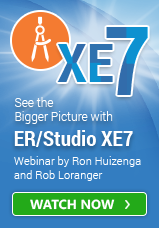On April 28, 2015, Embarcadero announced the XE7 release of our award-winning ER/Studio data modeling and architecture suite, with new features to improve agility and collaboration in enterprise data landscapes. Let’s highlight them, and for more details and a demonstration, you can watch the on-demand webinar from April 30th.
ER/Studio continues to incorporate new capabilities and features to improve the user experience, enhance the data architecture, and address emerging industry technologies and techniques. The flagship ER/Studio Data Architect and Data Architect Professional Editions feature enhancements, including:
• Automatic application of naming standards bound to entities for logical to physical mapping: Data modelers will be able to assign a naming standards template to their model, and as they add entities and modify attributes, those naming standards will be applied automatically between the logical and physical models, simplifying the modeling process.
• New ‘Start Here’ welcome page with dynamic content (such as how-to videos) improves the user experience and shortens learning ramp-up time: This will provide access to content such as how-to videos, new feature details, and other collateral, to improve their experience and reduce their learning curve with the tool.
The Data Architect Professional Edition and Enterprise Team Edition include a new capability that incorporates the Repository:

• Agile change management, including tasks and version history, enables modelers to keep data models relevant with fast-changing databases and applications: This capability to create and track tasks associated with data models will enable data architects to ensure their models stay aligned with the database and application development efforts using an Agile workflow.
The ER/Studio Enterprise Team Edition combined with the ER/Studio Team Server provides significant improvements in addition to those listed above:
• Glossary audit trails for change history: Changes made to glossaries and terms can be tracked with detailed audit trail histories, including who made the change and what was changed.
• Glossary hierarchies with inheritance: Glossary hierarchies with inheritance allow creation of child glossaries that can inherit a subset of terms from one or more glossaries, to create tiered structures that correlate to organizational configurations.
• Team Server glossary integration with the ER/Studio Data Architect data dictionary: This allows modelers to see business terms and definitions in real-time in their entity attributes within the modeling tool and workflow.
• Ability to make mass updates to a subset of glossaries and terms (instead of all at once or one at a time) using CSV modifications: This expands the existing export capability to allow only selected terms to be saved into a CSV file
• Data source mappings: This ability to map data sources to the data models allows data professionals to identify and analyze data source impacts resulting from model changes.
• Enhanced advance search capabilities: This enables better granularity for searching across the glossaries, terms, data sources, and data objects
See the What’s New page for the summary of the new XE7 features along with which editions each one applies to. If you have any questions about ER/Studio, let us know.
Since you’re reading this on the Community site, please join the newly created ER/Studio Virtual User Group that we’ve set up here. You can also submit your ER/Studio questions to our Answers page, and start or contribute to a discussion in the Forum. This new Community site is just ramping up, and we need participation from you to make it thrive. Thanks for being a part of the ER/Studio family!
______________________________________________________________________________